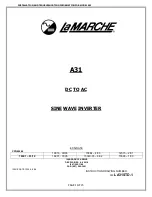
23
E
N
N
L
F
R
D
E
E
S
S
E
A
p
p
en
d
ix
7. ERROR INDICATIONS
With the procedures below, most errors can be quickly identified. If an error cannot be resolved, please refer to your Victron
Energy supplier.
7.1 General error indications
Problem
Cause
Solution
Quattro will not switch over
to generator or mains
operation.
Circuit breaker or fuse in the
AC-in input is open as a result of overload.
Remove overload or short circuit on AC-out-1 or AC-
out-2, and reset fuse/breaker.
Inverter operation not
initiated when switched on.
The battery voltage is excessively high or too low.
No voltage on DC connection.
Ensure that the battery voltage is within the correct
range.
“Low battery” LED flashes.
The battery voltage is low.
Charge the battery or check the battery connections.
“Low battery” LED lights.
The converter switches off because the battery
voltage is too low.
Charge the battery or check the battery connections.
“Overload” LED flashes.
The converter load is higher than the nominal load.
Reduce the load.
“Overload” LED lights.
The converter is switched off due to excessively
high load.
Reduce the load.
“Temperature” LED flashes
or lights.
The environmental temperature is high, or the load
is too high.
Install the converter in cool and well-ventilated
environment, or reduce the load.
“Low battery” and “overload”
LEDs flash intermittently.
Low battery voltage and excessively high load.
Charge the batteries, disconnect or reduce the load,
or install higher capacity batteries. Fit shorter and/or
thicker battery cables.
“Low battery” and “overload”
LEDs flash simultaneously.
Ripple voltage on the DC connection exceeds
1,5Vrms.
Check the battery cables and battery connections.
Check whether battery capacity is sufficiently high,
and increase this if necessary.
“Low battery” and
“overload” LEDs light.
The inverter is switched off due to an excessively
high ripple voltage on the input.
Install batteries with a larger capacity. Fit shorter
and/or thicker battery cables, and reset the inverter
(switch off, and then on again).
One alarm LED lights and
the second flashes.
The inverter is switched off due to alarm activation
by the lighted LED. The flashing LED indicates that
the inverter was about to switch off due to the
related alarm.
Check this table for appropriate measures in regard
to this alarm state.
The charger does not operate. The AC input voltage or frequency is not within the
range set.
Ensure that the AC input is between 185 VAC and 265
VAC, and that the frequency is within the range set
(default setting 45-65Hz).
Circuit breaker or fuse in the
AC-in input is open as a result of overload.
Remove overload or short circuit on AC-out-1 or AC-
out-2, and reset fuse/breaker.
The battery fuse has blown.
Replace the battery fuse.
The distortion or the AC input voltage is too large
(generally generator supply).
Turn the settings WeakAC and dynamic current limiter
on.
The battery is not completely
charged.
Charging current excessively high, causing premature
absorption phase.
Set the charging current to a level between 0.1 and 0.2
times the battery capacity.
Poor battery connection.
Check the battery connections.
The absorption voltage has been set to an incorrect
level (too low).
Set the absorption voltage to the correct level.
The float voltage has been set to an incorrect level
(too low).
Set the float voltage to the correct level.
The available charging time is too short to fully charge
the battery.
Select a longer charging time or higher charging
current.
The absorption time is too short. For adaptive
charging this can be caused by an extremely high
charging current with respect to battery capacity, so
that bulk time is insufficient.
Reduce the charging current or select the ‘fixed’
charging characteristics.
The battery is overcharged.
The absorption voltage is set to an incorrect level
(too high).
Set the absorption voltage to the correct level.
The float voltage is set to an incorrect level (too
high).
Set the float voltage to the correct level.
Poor battery condition.
Replace the battery.
The battery temperature is too high (due to poor
ventilation, excessively high environmental
temperature, or excessively high charging current).
Improve ventilation, install batteries in a cooler
environment, reduce the charging current,
and
connect the temperature sensor
.
The charging current drops to
0 as soon as the absorption
phase initiates.
The battery is over-heated (>50°C)
Install the battery in a cooler environment
Reduce the charging current
Check whether one of the battery cells has an internal
short circuit
Defective battery temperature sensor
Disconnect the temperature sensor plug in the
Quattro. If charging functions correctly after
approximately 1 minute, the temperature sensor
should be replaced.
Summary of Contents for Quattro 24
Page 2: ......
Page 4: ......
Page 58: ......
Page 114: ......
Page 161: ...19 EN NL FR DE ES SE Appendix Er ro r float Err or Ob temperatur ...
Page 171: ...29 EN NL FR DE ES SE Appendix Er ro r float Err or Ob temperatur ...
Page 190: ......
Page 191: ...1 EN NL FR DE ES SE Appendix APPENDIX A Overview connections ...
Page 196: ...6 APPENDIX C Parallel connection ...
Page 197: ...7 EN NL FR DE ES SE Appendix APPENDIX D Three phase connection ...
Page 200: ...10 APPENDIX G Dimensions ...
Page 201: ......
Page 202: ......
Page 203: ......
















































